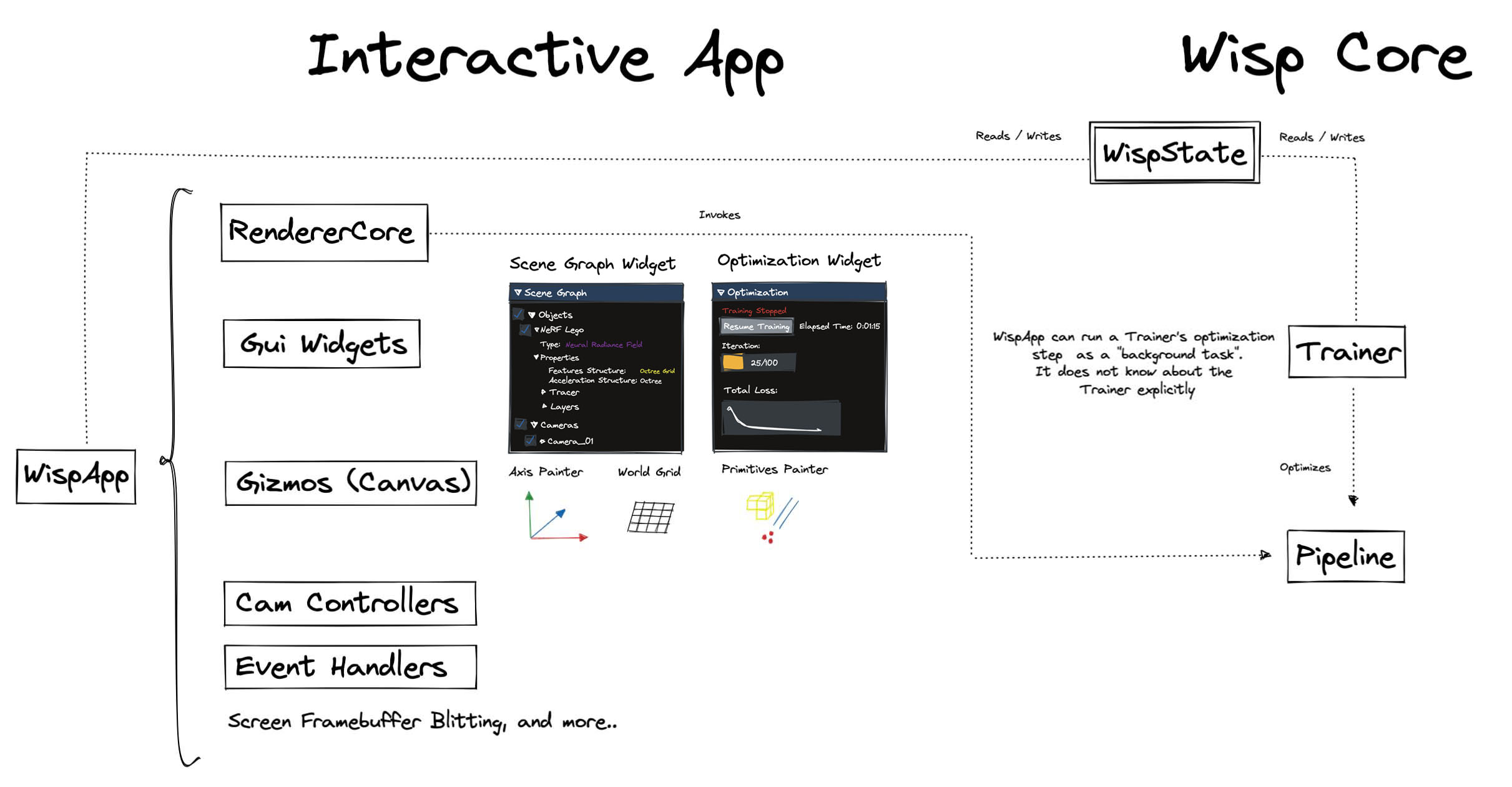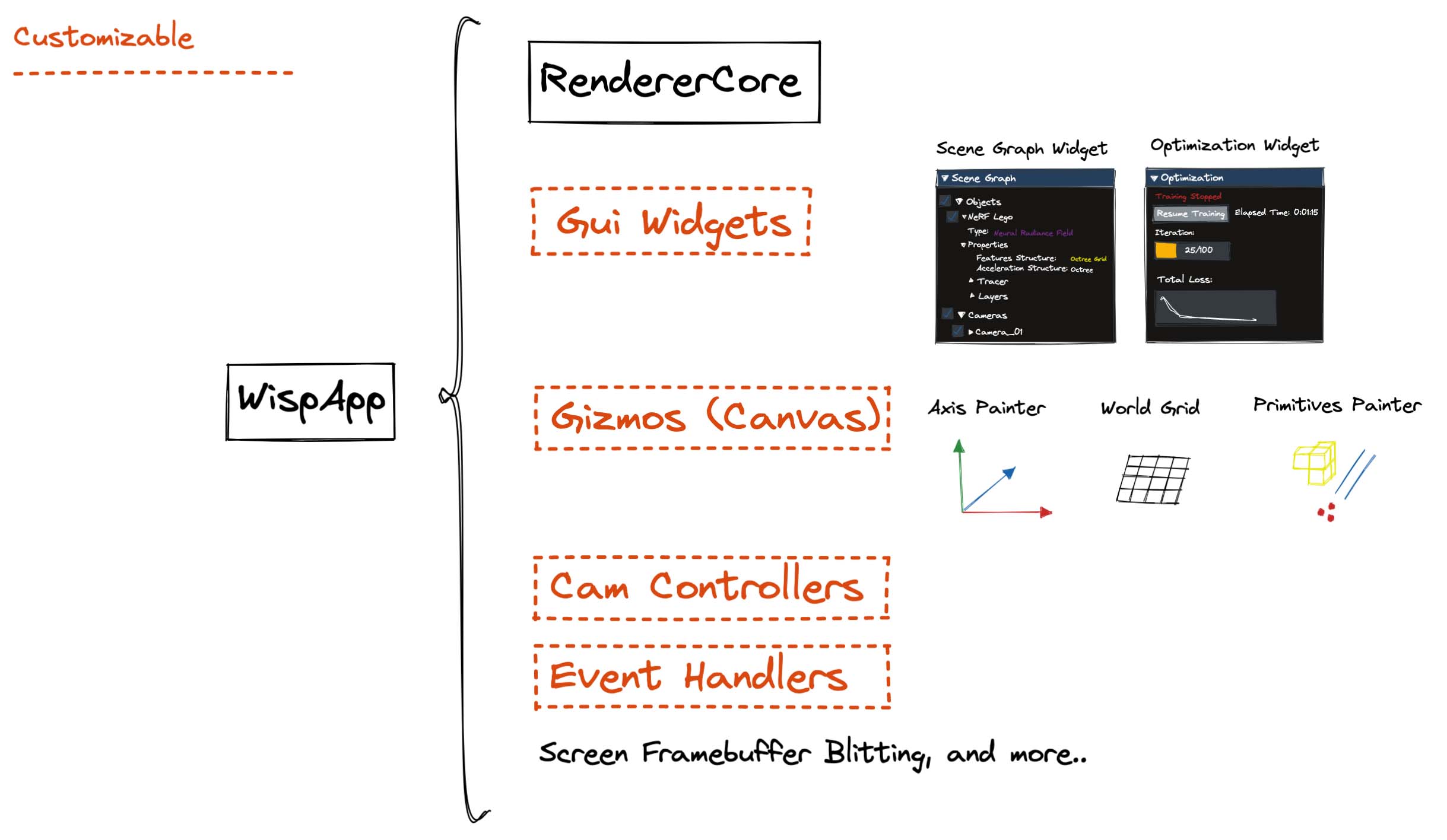Wisp Renderer#
This folder contains the logic for Wisp’s interactive visualizer.

For Beginners#

The app controls which gui widgets are created and how visual properties of the canvas are customized.
It can also register event handlers due to changes within the shared WispState object.
The scene graph can also be manipulated here.
To create your own interactive app, simply subclass WispApp from wisp/renderer/app/wisp_app.py and customize its behaviour.
See wisp/renderer/app/optimization_app.py for a working example (it’s recommended to clone and modify this file).
App modifications are possible by manipulating the WispState object, or overriding specific WispApp methods.
Wisp is already packed with an app for interactive visualization of optimizations.
See OptimizationApp from wisp/renderer/app/optimization_app.py.
Extending Apps#
The interactive visualizer gui and canvas can be extended with new components:
widgetscontrol the behaviour of the gui. New widgets can be added by implementingWidgetImguiusing theimgui.gizmosare painted over the canvas. New gizmos can be added by implementingGizmowithglumpyandOpenGL.
Newly added widgets and gizmos can be directly added to the WispApp.
The SceneGraph#
wisp/renderer/core/api/scenegraph.py contains the interface for manipulating the scene graph.
New objects can be added or removed from the scene, and the renderer can be requested to fully redraw the scene
to reflect recent modifications.
Neural field objects are represented in the form of Pipeline objects (a combination of a Neural Field and a Tracer).

Additional Public API#
wisp/renderer/core/api contains the logic required for supporting new types of objects with the interactive visualizer.
base_renderer.py contains the basic entities used by the renderer.
All renderable objects must implement the BottomLevelRenderer interface, which knows how to produce:
A
RenderBufferof the rendered object from the current view.DataLayers, represented as vector
PrimitivesPackobjects.
Wisp further distinguishes between ray-traced objects and rasterized ones with the RayTracedRenderer and RasterizedRenderer subclasses.
Advanced: implementing a BottomLevelRenderer / RayTracedRenderer#
When wisp observes a new neural object’s Pipeline in the scene graph, it will attempt to construct the matching RayTracedRenderer
(this process is governed by wisp/renderer/core/api/renderers_factory).
To ensure the factory knows how to perform this matching: a RayTracedRenderer should be registered with the tracers and neural fields it supports:
register_neural_field_type()from the factory model can be used directly.The
@field_rendererdecorator can also be used to conveniently registerBottomLevelRendererimplementations with compatible(BaseNeuralField, BaseTracer)pairs.
When the factory finds about a new neural Pipeline object, it will try to create a corresponding RayTracedRenderer instance in the following scheme:
Look for a
RayTracedRenderermatched with thePipelinetracer and neural field.If no matching
RayTracedRendererwas found, recurse through the neural field hierarchy and look for a match with tracer and the parent neural field classes.If no matching
RayTracedRendererwas found, recurse through the tracer hierarchy and look for matches with the parent tracer and the neural field classes explored in step 2.
If no renderer was found, the interactive app will assert.
Should you implement a BottomLevelRenderer / RayTracedRenderer?#
Wisp is shipped with NeuralRadianceFieldPackedRenderer and NeuralSDFPackedRenderer, both are registered with the BaseNeuralField, as well as PackedRFTracer and PackedSDFTracer respectively.
New type of Neural Fields supported by the default tracers (i.e. PackedRFTracer and PackedSDFTracer) will automatically be supported by these implementations.
A BottomLevelRenderer should usually be implemented if:
You’ve implemented a new type of Tracer, which is incompatible with the default
BottomLevelRendererimplementations.You’re interested in augmenting a bottom level renderer with additional data layers.
You’re implementing a non-neural object which is not supported by the above.
Note that in some cases, it’s enough to register your new tracer or neural field with the default renderers.
Where do the RayTracedRenderer args come from?#
When a RayTracedRenderer is constructed out of a Pipeline, wisp will query the tracer’s arguments.
The RayTracedRenderer will then use a new instance of the tracer, constructed using the Pipeline’s tracer args, to ensure the interactive visualizer does not interfere with any ongoing neural optimization.
Why are they called BottomLevelRenderers?#
To support future primitives, wisp’s definition of “renderable” objects is fairly loose.
BottomLevelRenderers are expected to produce RenderBuffer which can be blended to form the final framebuffer displayed on the canvas.
For optimization reasons, BottomLevelRenderers can be thought of leaf nodes within the scene graph managed by some Top Level Acceleration Structure (TLAS).
See the full diagram below.
The Renderer Core#
The Renderer Core is responsible for all drawing logic unrelated to the gui or a specific graphics api (i.e. gizmos assume OpenGL implementations and are handled separately).



